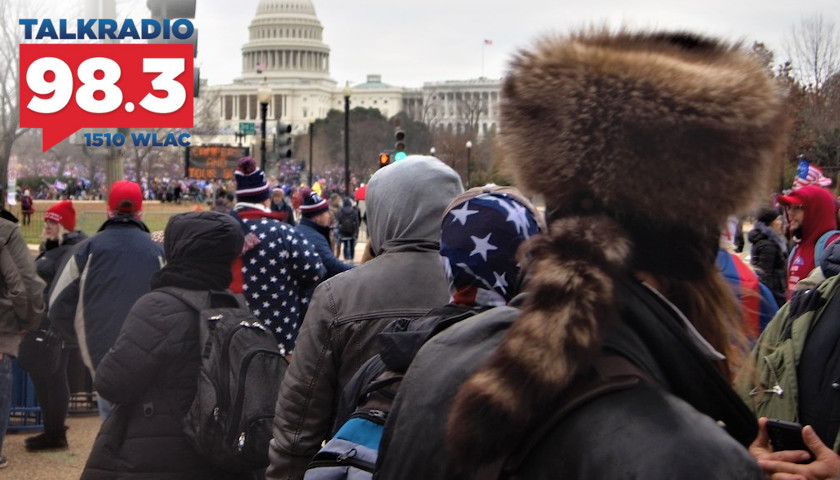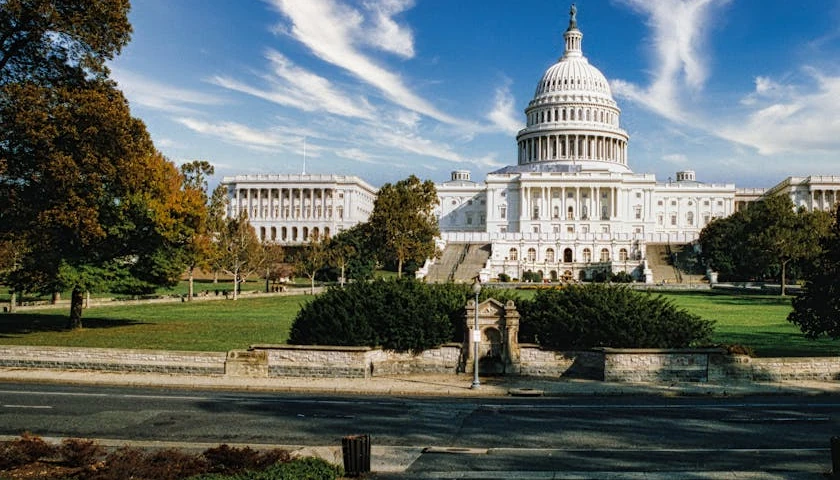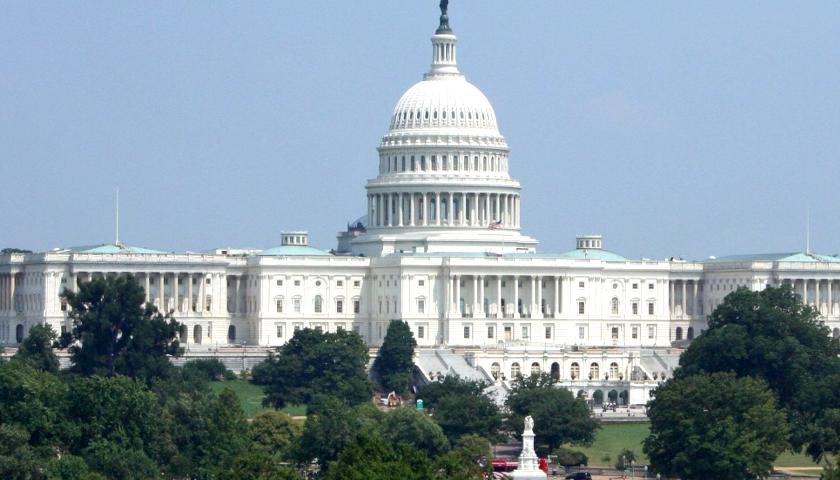Live from Music Row Monday morning on The Tennessee Star Report with Michael Patrick Leahy – broadcast on Nashville’s Talk Radio 98.3 and 1510 WLAC weekdays from 5:00 a.m. to 8:00 a.m. – host Leahy welcomed Senior Analyst for Strategy at the Center for Security Policy in Washington, D.C. Michael Waller to the newsmakers line to discuss what he personally witnessed while at the Save America Rally and Capitol breach last week.
Leahy: We are joined now on our newsmaker line by Michael Waller a senior analyst for strategy at the center for security policy in Washington. Good morning Michael.
Waller: Good morning, Michael.
Leahy: Thanks so much for joining us.
Waller: I read with great alarm your eyewitness account of what happened at the Capitol. Just give us the highlights of this. It’s a little different what you reported versus what we’ve seen in the mainstream media reporting on it.
Waller: Sure. Well, you had to be trained as a left-wing protester to recognize it. And I had been long ago when I was a foolish high school kid. And it was good training which allowed me to see you right away that there was trouble coming. This is not just a bunch of people who support their president and support clean elections and who are patriotic but there there are people in the crowd who were here to mess things up. What I didn’t realize I was just how they were going to mess things up. But I detected four different cells just in my area where I was.
Leahy: Where were you? Did you attend the rally at the mall? And what time did you move towards the lawn of the Capitol subsequently? Give us a timeline to begin with.
Waller: Okay. I was there and I got their start around noonish right after the President spoke. And I didn’t hear the speech but I walked right from 16 blocks between the White House and the Capitol building. So I did that whole length on Constitution Avenue, which is straight from the White House to Capitol Hill. And people were from all over the country as well and we’re excited to be in D.C.
It was a pretty festive atmosphere, even though people were really upset and angry at Congress. But they weren’t an angry mob at all. They were literally picking up one another’s litter if somebody dropped a piece of paper or a rapper of some kind. It was that kind of a group. And people socialized and they and they just made conversation with each other. But among those people, I was probably three blocks in and probably 15 or 20 minutes behind the very first of the marchers.
And we weren’t suspecting anything, but we did see people. We saw the ones now who became famous wearing uniforms and subdued clothing who were organized in a military-like fashion. They were traveling in clusters of two and three the whole time. They were not socializing with anybody. It looked like they were out there with a sense of purpose and they they didn’t fit in. There was another group wearing Trump hats or MAGA hats backward. And we had heard that Antifa was going to do that and they looked like they didn’t fit in also. And they also didn’t socialize.
Leahy: Let me let me ask you this. Can you recall how many people in the crowd you personally saw that we’re wearing Trump hats backward?
Waller: Well every now and then you’d see somebody who was. but not four, five, six people in a group.
Leahy: Right. All told how many backward Trump has would you say you saw you personally saw?
Waller: Oh, probably 20 and maybe 20 in groups.
Leahy: Okay. Okay, interesting.
Waller: And then the occasional kid, but it didn’t count those. Then there was the second group and I didn’t really take note of them until things started to get heated up. The third group was people dressed in MAGA gear but who were really really organized and aggressive. And this wasn’t typical of rallies with who was there. There were a lot of those and it was there the first time in Washington or they were really jazzed up after seeing their President, but they weren’t going to smash things up.
There were people in the very front who I didn’t see until after I got up to the Capitol building. I was about 40 feet away from them by then right near the front of the trouble. But these guys were out there to do damage. And this is where we saw that there were hundreds if not thousands of flags of all kinds. American flags, MAGA Flags, you name it. People carrying their state flags. But of all of those many flags, I only saw two Confederate battle flags.
And every now and then at a big protest of conservatives, somebody will come up with a Confederate flag and it’s more of a Southern Pride and Good Ol’ Boy kind of thing rather than anything else. But these two Confederate flags were right up in the front. And I know from experience that anytime you see that up in the front for everybody to see those are probably agitators who were brought up there to make the rest of the crowd look bad. (Inaudible talk) the rallying point for certain people.
And I remember thinking oh boy, these two flags are going to be all over the news. And sure enough, they were. And then we’re up there at the very base of the inaugural platform. There had been no police presence the whole time and we didn’t realize so much later that the police had felt outnumbered by the militant people in the front and took off. But during a joint session of Congress where you have the House and the Senate all meeting in the House chamber plus the Vice President of the United States the police security is going to be really really tight and no one gets up on the Capitol lawn. In this case, there was nobody there.
Leahy: Wait just a moment. You’re telling me there was no Capital police on the Capitol lawn?
Waller: We saw zero Capitol police on the Capitol lawn when we marched through. Usually, there’d be many many dozens at least.
Leahy: Usually like on a normal day. Not a day when they’re 300,000, you know people rallying at the mall just before.
Waller: Right. Plus a joint session of Congress would be a high-security event because the Vice President’s going to be there.
Leahy: So it’s a high-security event with a low-security capitol hill police presence. what’s wrong with that picture?
Waller: Right. It didn’t make any sense at all. And so by the time we got up there, there were some kids who climbed the TV camera tower. It’s a temporary tower that’s been erected right in front of the inaugural platform so that the news media can get good shots of the new president being sworn in and all the other people there. And so a bunch of kids had climbed up there and they were flying flags from the media tower. And I remember thinking the cops are going to take them down in no time. It didn’t happen.
Leahy: It did not happen.
Waller: It didn’t happen for a couple of hours.
Leahy: How many from your point how far away were you from at your closest point to the actual doors and the windows in the Capitol building where the doors opened in many cases by the police? The windows were broken by some of the protesters. How far away were you from the entrance to the Capitol building itself?
Waller: Probably about 80 feet. Now I’m on the western side, which is the side facing the White House. The right scenic part. That is where the crypts level of the Capitol is. The basement level where they busted in through the very narrow entrance. I was not up to at the site of the Eastern side of the Capitol which is where people rushed up the stairs. So it’s two different sides. This was a flat area level place where they broke in.
We didn’t suspect at all that they would break in because this was you know, this was the inaugural stand for the incoming president. And I’ve been here since Reagan’s first inaugural so I’ve seen these inaugural stands go up. And you don’t get within 300 feet of those things even in normal times. And we got to go right up to it and I wasn’t there close enough to touch it, but other people were.
And then the anti-riot police started coming in and they stood on the inaugural platform right where Biden’s going to be sworn in, on that exact spot. And they appeared with tear gas, guns, and paintball guns that fired pepper balls and some other weapons I didn’t recognize because it was just, they were unfamiliar types. There were about maybe 30 to 50 of them at any given time but they didn’t stay long. There was some trouble in the front and we didn’t know what it was. We just thought it was thousands of people packing into this tiny relatively tiny area and more just pouring in from the march for a good hour or more.
Leahy: In your view Michael how many Capitol police officers and perhaps others, how many should there have been to accommodate a crowd of this size?
Waller: Well at a time like this you bring in people for overtime. Capitol police are 300 person force so I figured you should have had at least 500 of them at a minimum on our side of the Capitol and then reinforce them with park police and the federal police for the national parks. And then Washington D.C. city police who are trained to handle these issues.
Leahy: And how many were there?
Waller: I saw at tops between 30 and 50 and they looked confused like they didn’t have good leadership or they didn’t have good command and control. I mean these are professional officers there. I’ve worked off and on the Capitol police for years. So they’re really professional officers. It’s just that they didn’t have decent Rules of Engagement and there weren’t enough of them and they obviously didn’t know what to do.
Leahy: When we come back We’re going to ask the big question. Why were there not more police there and why didn’t they have rules of engagement and who controls the Capitol police? We’ll be back with Michael Waller, an eyewitness to the Capitol breach after this.
(Commercial break)
Leahy: Dr. Waller, you were an eyewitness there. We left your description of the events when the Capitol was breached on January sixth with you saying that the Capitol Hill police had at a max of about 50 officers there. They needed at least 500 to handle a crowd of this size. You’ve worked with the Capitol Hill police. Why did they make such a bad decision?
Waller: I have no idea why they did that. They were fully prepared. It was known that there were going to be a huge amount of people there. And most of all it was a joint session of Congress where you had the successors to the presidency in there. You had the Vice President. You have the Speaker of the House. The president pro-tempore of the Senate all in the same room yet we all saw on the videos how the mob element of this group was actually able to breach the last door to the House of Representatives chamber.
Leahy: You said you’ve worked with the Capitol Hill Police in the past. They have a record of being solid and professional. And the individual officers there acted professionally, but they had no leadership. They didn’t know what their Rules of Engagement were. How on earth could the now resigned Capitol Hill chief of police Steven Sund, how could he have set up such a program?
Waller: Well, it’s easy to blame the chief of police when the police are not adequately prepared. And that’s fine. But that chief of police has a boss. On the House side, it’s the house Serjeant-at-arms and on the Senate side, it’s the Senate Serjeant-at-arms. And they have a boss. And those bosses are the Speaker of the House Nancy Pelosi and the majority leader of the Senate and minority leader of the Senate Mitch McConnell and Chuck Schumer.
So the buck stops with them. The Senate elects the chief of police and the Senate elects the panel that governs the chief of police. And so it’s the leaders of the House and Senate that govern them. And they failed to govern. They did not do their job.
Leahy: So let’s get to this. Do we know if Speaker Pelosi had any conversations with the sergeant of arms and then in turn the Capitol Hill police chief? Do we know if Senator McConnell and Senator Schumer had any conversations with the Serjeant-at-arms for the Senate and the Capitol Hill police chief asking, are you prepared for a large crowd? Did they have those conversations?
Waller: We don’t know. I haven’t seen any of them come up and say hey we were prepared because we gave them these instructions or we had a status report. You don’t see any of that. You see finger-pointing at the guys in blue.
Leahy: Is it a possibility if you were, let me just say this. If you were the Speaker of the House would it have been a duty prior to the meeting of the joint session to have a conversation with the sergeant of arms at the House in detail about the preparations for the reaction to this protest rally that they knew would come towards the Capitol?
Waller: Well, you would at least expect them to have a periodic review of the procedures in the event of a large crowd and especially a large crowd that was angry with Congress. Now, this was not an aggressive crowd. And nobody could foresee an assault like this. But can you imagine if it was a six-man squad that was armed?
They could have wiped out the whole Congress. And what we could see from the videos is they not only did they breach the Capitol building which never should have happened, but they went through a maze of passageways and stairways and actually tried to smash their way through into the chamber of the House while it was in session. There are rules of procedure for that that should always be reviewed. And it looks like that never happened.
Leahy: I mean, it looks like there were two elements of the people that were inside. Some of the doors were opened to some by the police.
Waller: Right. And these are not Home Depot doors. These are big heavy two and a half three-inch-thick mahogany, oak, and bronze doors. If the doors were simply kept shut those people would not have gotten in and then the police could have concentrated on the window where they did get in.
Leahy: Why didn’t they do that?
Waller: No idea. It’s not explainable. And then to see from the videos, which we could not see. We weren’t up at the breach but the police greeted a lot of them and escorted them and ushered them in. There’s a video that just got out last night by somebody from the Senate floor videoing with the sort of this sort of wimpy beta kind of policeman saying this is a sacred place would you guys please be careful. Rather than call reinforcements and have them taken out, there were police milling around outside the Senate chamber while that guy in the fur outfit with horns was up there sitting in the Vice President’s seat.
Leahy: That’s crazy. They just didn’t do their job.
Waller: No, they didn’t. I’m really exasperated now just thinking about it because I used to work in the Senate and I love that place. Not necessarily the people but you protect that place at all costs. It’s like if somebody invades your home even in D.C., the way the politics are, you have a legal right to use lethal force to defend your home.
And in this case where you have people say screaming hang the Vice President and attacking and smashing in the doors of Congress. You saw that somebody did shoot one woman. And it’s sad to say it but if you’re going to break down the door to the House of Representative and smash through the glass and try to climb through it’s the obligation of the guards on the other side to shoot them.
Leahy: Yeah, exactly.
Waller: And I’m surprised it was only one person.
Leahy: Michael Waller, thanks for that eyewitness report. Will you come back? Because we’re going to be looking and several news outlets will, what the responsibilities of the chief of police, the Serjeant-at-arms of the House and the Senate, Speaker Pelosi, Minority Leader Schumer at the time, of Majority Leader McConnell. We’re going to look at what their duties and responsibilities were and did they execute them properly.
Listen to the full first hour here:
– – –
Tune in weekdays from 5:00 – 8:00 a.m. to the Tennessee Star Report with Michael Patrick Leahy on Talk Radio 98.3 FM WLAC 1510. Listen online at iHeart Radio.
Photo “Capitol Protest” by Tyler Merbler. CC BY 2.0.





